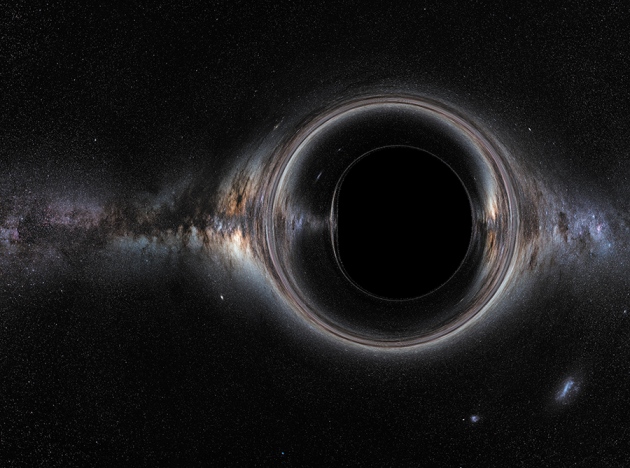We've long known that black holes come in two flavors. There are stellar black holes, which form when a giant star collapses in on itself, compressing the mass of five or more our suns into an infinitely small point. They just float around the universe, sucking up anything that gets in their way.
And then there comes the
supermassive black holes. These are a lot more mysterious, and their mass can
be as high as millions or even billions of our suns. They
don't go anywhere, but stay at the center of their galaxies like the hubs of a
cosmic wheel. But it always seemed strange to astronomers that there were
itty-bitty black holes and mega-gigantic black holes, but nothing in between.
Until now.
Supermassive black holes are sort of the linchpin of
the galaxy. In 1971, astronomers Donald Lynden-Bell and Martin Rees hypothesized
that instead of being empty, the blank spaces at the center of every galaxy
might actually contain these insatiable giants, and in 1974, we proved there
was one at the middle of the Milky Way. It's called Sagittarius A*, because
that's what happens when you let scientists name things.
Since then, we've
discovered the effect that giant black holes have on their galaxies.
The bigger the black hole, the bigger the galaxy, and the faster it spins. So
that suggested that the black holes might actually play a role in how galaxies
are formed — but if they were there before the galaxy was, then where did they
come from?
You might think that stellar
black holes could cast some light on the mystery, but it turns out
they are notoriously bad at casting light on anything. These things are way tinier than their supermassive
counterparts, like billions of times tinier, making it very unlikely that
stellar black holes have anything to do with supermassive black holes creation.
So what gives?
In 2016, observers at Japan's Keio University noticed something that just
might link the two types of black holes. A gas cloud near the center of the
galaxy (but not inside it) was found to be accelerating in a strange way that
suggested it was being influenced by a giant black hole. But not too giant
— they're calling this one an "intermediate-mass black hole".
And if it really is the
black hole they think it is, it's still about a million times smaller than ol'
Sagittarius A*. That actually means that it could finally reveal how the
supermassives form, growing slowly by sucking up errant gas until they get big
enough to either form the core of a new galaxy, or crash into the central
supermassive black hole of the galaxy they're currently in. Black holes are
really awesome.
How Big Are Black Holes?
Ready for a head trip? We've
been talking about how big black holes are, but in fact, the stellars, the
intermediates, and the supermassives are all the exact same size. That's
because a black hole is just any non-zero amount of matter condensed into a
one-dimensional point — and more matter means high density.
Still, you can judge the
size of a black hole by the size of its event horizon. That's the radius surrounding the black hole
at which you would have to be moving at the speed of light in order to escape
its gravitational pull. The denser the hole, the larger the event horizon. The
radius encompassing the event horizon of a black hole is called a Schwarzchild
radius, and to the naked eye it would appear to be a completely black sphere,
since no light can escape its grasp.
Curious about what your
Schwarzchild radius would be? You can calculate it just right here. If the sun were to
collapse into a black hole tomorrow (which, just so you know, is totally
impossible), then its event horizon would be about 2.95 kilometers (about 1.83
miles) from its center. The smallest black hole we know about has the mass of
3.8 suns, making its Schwarzchild radius about 11 kilometers (7 miles).
Even the largest stellar
black hole would only have an event horizon extending out 46 kilometers (28
miles) — that's just a 30-minute drive on solid ground. And then there's
Sagittarius A*. Its event horizon extends 13.3 million kilometers (8.26 million
miles) in every direction. We wouldn't recommend that as a commute, even if
there weren't any black holes around.
Via Curiosity.com
Via Curiosity.com

:quality(75)/curiosity-data.s3.amazonaws.com/images/content/landscape/standard/6f78477f-3893-4d90-aac9-f49be452a394.png)

